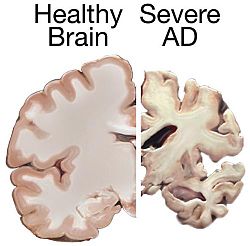Dementia
 From Wikiversity - Reading time: 3 min
From Wikiversity - Reading time: 3 min
This is a start page for learning about dementia (from the Latin for "without mind").
See also: Caregiving and dementia.

| Completion status: this resource is ~50% complete. |
What is dementia?
[edit | edit source]Dementia is a gradual, serious loss of global cognitive ability in a previously unimpaired person, beyond what might be expected from normal aging.
Dementia is a very significant world-wide health care issue.
See also:
- Dementia (Wikipedia)
- What is Dementia? (Alzheimer's Australia fact sheet:)
How does dementia feel?
[edit | edit source]- Read this Alzheimer's message board discussion about how it feels to have dementia and how this varies between people
- Watch this 5 min. video about dementia and motivation
The numbers
[edit | edit source]- 36 million people in the world have dementia (Banerjee, 2012)
- It will double by 2030 and there will be 115 million with dementia by 2050
- The social cost is enormous - US$600 billion per year (bigger than the biggest company of the world and biggest than cancer, diabetes, etc., i.e., around 1% of the world's economy, equivalent to the 18th biggest economy of the world)
- 60% of the costs of aging care are due to dementia
See also: Alzheimer's disease facts and figures (Alzheimer's Association, USA, 2013)
Myths about dementia
[edit | edit source]- It is not a normal part of ageing
- That nothing can be done to help prevent or treat dementia
- Stigma of dementia prevents discussion with the person with dementia
- Having dementia means that a person is completely dependent
Types of dementia
[edit | edit source]Here is a description of some of the more well-known types of dementia (Access Economics, 2009) -
- Alzheimer’s Disease, most common and usually affects the temporal lobes of the brain with consequent deterioration in memory,
- Vascular Dementia, caused by mini strokes and more sudden onset than Alzheimers, can occur anywhere in the brain,
- Dementia with Lewy Bodies (abnormal proteins form in certain areas of the brain) tends to affect the visual cortex among other areas of the brain,
- Frontal Lobe and Fronto-Temporal Dementia (eg Pick’s Disease where abnormal amounts of tau protein form in nerve cells)
- Alcohol-related Dementia (Korsakoff’s Syndrome)
- Parkinsons Disease (affects nerve cells’ production of dopamine, which affects muscle movement and balance)
- Huntingtons Disease is usually hereditary (behaviour changes such as irritability, moodiness, restlessness, paranoia and psychosis may be evident before movement problems emerge such as jerking movements, unsteady walking, involuntary facial movement)
- AIDS-related Cognitive Decline
For more information, see Types of Dementia (Alzheimer's Australia)
What is needed?
[edit | edit source]- National Dementia Strategies to prioritise health-care goals and strategies
- Vision
- System change
- Ambition in scale
- Investment
- Commitment over time
- Leadership
- Health Promotion campaigns to educate carers, families, health professionals
- Good-quality earlier diagnosis and intervention
- Only a third of most of people with dementia received any special health care assessment or diagnosis. When they do it is:
- late in the illness too late to enable choice
- at a time of crisis
- too late to prevent harm or crises.
- Only a third of most of people with dementia received any special health care assessment or diagnosis. When they do it is:
Quality of life
[edit | edit source]Quality of life (QOL) is unrelated to severity of dementia. However, there is considerable variability in QOL. Quality of understanding, diagnosis, and care then are important aspects of the health and well-being of those with dementia.
See also
[edit | edit source]On Wikiversity:
- Caregiving and dementia
- Dementia and motivation (Book chapter)
- Prevention of dementia
- Category:Dementia
On Wikipedia:
References
[edit | edit source]- Banjeree, S. (2012). Professor Sube Banerjee commences Australian tour. Australian Alzheimer's Association.
- Standard and Poor (2010). Global ageing 2010: An irreversible truth.
- Alzheimer's Disease International (2011). Alzheimer Report.
External links
[edit | edit source]- Alzheimer's Association (USA)
- Alzheimer's Disease International (UK)
- Alzheimer's Association Australia
- Dementia Collaborative Research Centres (Australia)
- Dementia Today: Scientific news and professional views on Alzheimer’s disease and other dementias
- Facts about dementia from Alzheimer's Australia (University of Wollongong, Australia)
 KSF
KSF